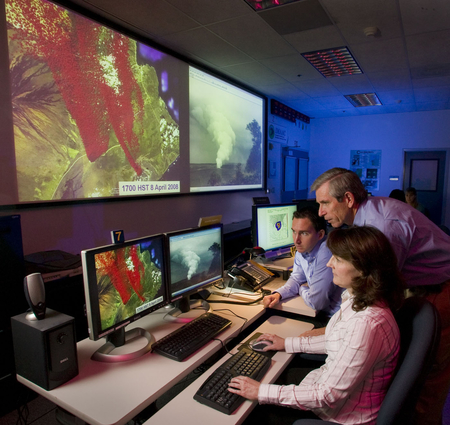NNSA highlights 30 years of LLNL's National Atmospheric Release Advisory Center
 (Download Image)
Control room of the National Atmospheric Release Advisory Center at Lawrence Livermore National Laboratory.
(Download Image)
Control room of the National Atmospheric Release Advisory Center at Lawrence Livermore National Laboratory.
WASHINGTON, D.C. -- The National Nuclear Security Administration (NNSA) today marked the 30th anniversary of the National Atmospheric Release Advisory Center, also known as NARAC.
Located at NNSA's Lawrence Livermore National Laboratory (LLNL), NARAC provides near-real-time computer predictions of the transport and deposition of hazardous airborne materials.
"NARAC is a key component of NNSA Emergency Response teams, and, along with other NNSA assets, provides the nation with critical expertise to help resolve radiological emergencies," said NNSA Associate Administrator for Emergency Operations Joseph Krol. "On behalf of NNSA, I congratulate everyone at NARAC for their invaluable contributions to our nuclear security mission over the last three decades."
The center opened in 1979, when the Department of Energy and LLNL used the newly developed modeling system to generate predictions that helped guide federal and state measurement teams working to determine the impact of radiological material released from the Three Mile Island nuclear power plant.
Since then, NARAC has been used by decision makers and emergency responders to predict the impacts of hazardous atmospheric releases in order to protect lives and mitigate consequences.
NARAC modeling has been employed for the Chernobyl nuclear power plant accident, industrial chemical accidents, and hypothetical events such as the TOPOFF series of terrorism exercises.
The Department of Homeland Security's Interagency Modeling and Atmospheric Assessment Center, also know as IMAAC, uses NARAC as its primary resource for the coordination and dissemination of the Federal government's hazard prediction models during an incident.
NNSA's emergency response mission is to protect the public, environment, and emergency responders from both terrorist and non-terrorist events by providing a responsive, flexible, efficient, and effective radiological emergency response framework and capability for the nation. This mission is accomplished by applying NNSA's unique technical expertise residing within the national laboratories.
Established by Congress in 2000, NNSA is a semi-autonomous agency within the U.S. Department of Energy responsible for enhancing national security through the military application of nuclear science in the nation‚s national security enterprise. NNSA maintains and enhances the safety, security, reliability, and performance of the U.S. nuclear weapons stockpile without nuclear testing; reduces the global danger from weapons of mass destruction; provides the U.S. Navy with safe and effective nuclear propulsion; and responds to nuclear and radiological emergencies in the U.S. and abroad.
Founded in 1952, Lawrence Livermore National Laboratory has a mission to ensure national security and to apply science and technology to the important issues of our time. Lawrence Livermore National Laboratory is managed by Lawrence Livermore National Security, LLC, for the U.S. Department of Energy’s National Nuclear Security Administration.
Contact
Anne M. Stark[email protected]
925-422-9799
Related Links
NARAC fact sheetNARAC expands its reach: project aims at minimizing chemical-biological weapons casualties
National Nuclear Security Administration
NNSA emergency response assets




